Systematic Frequency and Statistical Analysis Approach to Identify Different Gas–Liquid Flow Patterns Using Two Electrodes Capacitance Sensor: Experimental Evaluations
Abstract
1. Introduction
1.1. Multiphase Flow Systems
1.2. Flow Patterns Identification Techniques
1.3. Frequency and Statistical Analysis
2. Experimental Apparatus and Methodology
2.1. Two Electrodes Capacitance
2.2. Statistical and Frequency Analysis Approach
3. Results and Discussion
3.1. Capacitance Time-Dependent Analysis
3.2. Frequency Analysis
3.3. Statistical Analysis
- It cannot construct tomography images in comparison with sensors that consist of eight or more electrodes.
- It suffers from lower resolution when compared to sensors with more than two electrodes (especially for large diameter pipes).
- It has high uncertainty in void fraction measurements (especially for post-intermittent flow regimes) when compared with sensors that have more than two electrodes.
4. Conclusions
Author Contributions
Funding
Acknowledgments
Conflicts of Interest
Nomenclature
| Latin Symbols | |
| C | Capacitance (F) |
| CG | Gas capacitance (F) |
| CL | Liquid capacitance (F) |
| C(statistical variable) | Capacitance of the sensor value (F) |
| m | Mean value (F) |
| din | Inner pipe diameter (mm) |
| dout | Outer pipe diameter (mm) |
| f | Frequency of the highest power spectrum (Hz) |
| Δƒ | Width of the characteristic frequency peaks (Hz) |
| N | Number of data points sampled |
| uGS | Superficial gas velocity (m/s) |
| uLS | Superficial liquid velocity (m/s) |
| ut | Translational velocity (m/s) |
| Greek Symbols | |
| Permittivity of free space (F/m) | |
| Standard deviation (F) | |
| Skewness | |
| Kurtosis | |
| β | Inclination angle |
| Abbreviations | |
| FFT | Fast Fourier Transform |
| PSD | Power spectral density |
References
- Soo, S.L. Dynamics of Multiphase Flow Systems. Ind. Eng. Chem. Fundam. 1965, 4, 426–433. [Google Scholar] [CrossRef]
- Alghamdi, A.Y.; Peng, Z.; Luo, C.; Almutairi, Z.; Moghtaderi, B.; Doroodchi, E. Systematic Study of Pressure Fluctuation in the Riser of a Dual Inter-Connected Circulating Fluidized Bed: Using Single and Binary Particle Species. Processes 2019, 7, 890. [Google Scholar] [CrossRef]
- Hua, L.; Lu, L.; Yang, N. Effects of liquid property on onset velocity of circulating fluidization in liquid-solid systems: A CFD-DEM simulation. Powder Technol. 2020, 364, 622–634. [Google Scholar] [CrossRef]
- Ekberg, N.P.; Ghiaasiaan, S.M.; Abdel-Khalik, S.I.; Yoda, M.; Jeter, S.M. Gas-liquid two-phase flow in narrow horizontal annuli. Nucl. Eng. Des. 1999, 192, 59–80. [Google Scholar] [CrossRef]
- Furukawa, T.; Fukano, T. Effects of liquid viscosity on flow pattern in vertical upward gas-liquid two phase flow. Int. J. Multiph. Flow 2001, 27, 1109–1126. [Google Scholar] [CrossRef]
- Van Hout, R.; Shemer, L.; Barnea, D. Evolution of hydrodynamic and statistical parameters of gas-liquid slug flow along inclined pipes. Chem. Eng. Sci. 2003, 58, 115–133. [Google Scholar] [CrossRef]
- Barnea, D. Transition from annular flow and from dispersed bubble flow-unified models for the whole range of pipe inclinations. Int. J. Multiph. Flow 1986, 12, 733–744. [Google Scholar] [CrossRef]
- Barnea, D.; Taitel, Y. Flow pattern in transition in two-phase gas liquid flows. Encycl. Fluid Mech. 1986, 3, 404–469. [Google Scholar]
- Al-Alweet, F. The Development of Capacitance Measurement Techniques and Data Processing Methods for the Characterisation of Two-Phase Flow Phenomena in Horizontal and Inclined Pipelines; The University of Manchester: Manchester, UK, 2008. [Google Scholar]
- Almutairi, Z.; Al-Alweet, F.M.; Alghamdi, Y.A.; Almisned, O.A.; Alothman, O.Y. Investigating the Characteristics of Two-Phase Flow Using Electrical Capacitance Tomography (ECT) for Three Pipe Orientations. Processes 2020, 8, 51. [Google Scholar] [CrossRef]
- Adewumi, M.A.; Bukacek, R.F. Two-phase pressure drop in horizontal pipelines. J. Pipelines 1985, 5, 1–14. [Google Scholar]
- Barnea, D.; Brauner, N. Hold-up of liquid in two phase intermittent flow. Int. J. Multiph. Flow 1985, 11, 43–49. [Google Scholar] [CrossRef]
- Ito, K.; Inoue, M.; Ozawa, M.; Shoji, M. A Simplified Model of Gas-Liquid Two-Phase Flow Pattern Transition. Heat Transf. Asian Res. 2004, 33, 445–461. [Google Scholar] [CrossRef]
- Bennett, D.; Woods, Z.F. Frequency and development of slugs in a horizontal pipe at large liquid flows. Int. J. Multiph. Flow 2006, 32, 902–925. [Google Scholar]
- Pongsiri, S.; Somchai, W. Tow-phase flow pattern maps for vertical upward gas-liquid flow in mini-gap channels. Int. J. Multiph. Flow 2004, 30, 225–236. [Google Scholar]
- Abouelwafa, S.M.; Kendall, E.J. The use of capacitance sensors for phase percentage determination in multiphase pipelines. IEEE Trans. Instrum. Meas. 1980, 28, 24–27. [Google Scholar] [CrossRef]
- Bangliang, S.; Zhang, Y.; Peng, L.; Yao, D.; Zhang, B. The use of simultaneous iterative reconstruction technique for electronic capacitance tomography. Chem. Eng. J. 2000, 77, 37–41. [Google Scholar] [CrossRef]
- Dyakowski, T.; Edwards, R.B.; Xie, C.G.; Williams, R.A. Application of capacitance tomography to gas-solid flows. Chem. Eng. Sci. 1997, 52, 2099–2110. [Google Scholar] [CrossRef]
- Elkow, K.J.; Rezkallah, K.S. Void fraction measurements in gas-liquid flows using capacitance sensors. Meas. Sci. Technol. 1996, 7, 1153–1163. [Google Scholar] [CrossRef]
- Gamio, J.C.; Castro, J.; Rivera, L.; Alamilla, J.; Garcia-Nocetti, F. Visualisation of gas-oil two-phase flows in pressurised pipes using electrical capacitance tomography. Flow Meas. Instrum. 2005, 16, 129–134. [Google Scholar] [CrossRef]
- Hammer, E.A.; Green, R.G. The spatial filtering effect of capacitance transducer electrodes. J. Phys. E 1983, 16, 438–443. [Google Scholar] [CrossRef]
- Jeanmeure, L.F.C.; Dyakowski, T.; Zimmerman, W.B.J.; Clark, W. Direct flow pattern identification using electrical capacitance tomography. Exp. Therm. Fluid Sci. 2002, 26, 763–773. [Google Scholar] [CrossRef]
- Kendoush, A.A.; Sarkis, Z.A. Improving the accuracy of the capacitance method for void fraction measurement. Exp. Therm. Fluid Sci. 1995, 11, 321–326. [Google Scholar] [CrossRef]
- Reinecke, N.; Mewes, D. Multielectrode capacitance sensors for the visualisation of transient two-phase flows. Exp. Therm. Fluid Sci. 1997, 15, 253–266. [Google Scholar] [CrossRef]
- Warsito, W.; Fan, L.S. Measurement of real time structures in gas-liquid and gas-liquid- solid flow systems using electrical capacitance tomography (ECT). Chem. Eng. Sci. 2001, 56, 6455–6462. [Google Scholar] [CrossRef]
- Yang, W.Q.; Chondronasios, A.; Nattrass, S.; Nguyen, V.T.; Betting, M.; Ismail, I.; McCann, H. Adaptive calibration of capacitance tomography system for imaging water droplet distribution. Flow Meas. Instrum. 2004, 15, 249–258. [Google Scholar] [CrossRef]
- Kong, R.; Rau, A.; Kim, S.; Bajorek, S.; Tien, K.; Hoxie, C. A robust image analysis technique for the study of horizontal air-water plug flow. Exp. Therm. Fluid Sci. 2019, 102, 245–260. [Google Scholar] [CrossRef]
- Polonsky, S.; Shemer, L.; Barnea, D. The relation between the Taylor bubble motion and the velocity field ahead of it. Int. J. Multiph. Flow 1999, 25, 957–975. [Google Scholar] [CrossRef]
- Clarke, N.N.; Rezkallah, K.S. A study of drift velocity in bubbly two-phase flow under microgravity conditions. Int. J. Multiph. Flow 2001, 27, 1533–1554. [Google Scholar] [CrossRef]
- Jaworski, A.J.; Bolton, G.T. The design of an electrical capacitance tomography sensor for use with media of high dielectric permittivity. Meas. Sci. Technol. 2000, 11, 743–757. [Google Scholar] [CrossRef]
- Makkawi, Y.T.; Wright, P.C. Fluidization regime in a conventional fluidized bed characterized by means of electrical capacitance tomography. Chem. Eng. Sci. 2002, 57, 2411–2437. [Google Scholar] [CrossRef]
- Prakash, B.; Parmar, H.; Shah, M.T.; Pareek, V.K.; Anthony, L.; Utikar, R.P. Simultaneous measurements of two phases using an optical probe. Exp. Comput. Multiph. Flow 2019, 1, 233–241. [Google Scholar] [CrossRef]
- Liu, T.J.; Bankoff, S.G. Structure of air-water bubbly flow in a vertical pipe—I. liquid mean velocity and turbulence measurements. Int. J. Heat Mass Transf. 1993, 36, 1049–1060. [Google Scholar] [CrossRef]
- Van der Welle, R. Void fraction, bubble velocity and bubble size in two-phase flow. Int. J. Multiph. Flow 1985, 11, 317–345. [Google Scholar] [CrossRef]
- Liu, T.J.; Bankoff, S.G. Structure of air-water bubbly flow in a vertical pipe II. Void fraction, bubble velocity and bubble size distribution. Int. J. Heat Mass Transf. 1993, 36, 1061–1072. [Google Scholar] [CrossRef]
- Libert, N.; Morales, R.E.M.; da Silva, M.J. Capacitive measuring system for two-phase flow monitoring. Part 1: Hardware design and evaluation. Flow Meas. Instrum. 2016, 47, 90–99. [Google Scholar] [CrossRef]
- Kong, R.; Rau, A.; Kim, S.; Bajorek, S.; Tien, K.; Hoxie, C. Experimental study of horizontal air-water plug-to-slug transition flow in different pipe sizes. Int. J. Heat Mass Transf. 2018, 123, 1005–1020. [Google Scholar] [CrossRef]
- Heerens, W.C. Application of capacitance techniques in sensor design. J. Phys. ESci. Instrum. 1986, 19, 897–906. [Google Scholar] [CrossRef]
- Williams, R.A.; Beck, M.S. Process Tomography Principle, Techniques and Applications; Butterworth-Heinemann Ltd: Oxford, UK, 1995. [Google Scholar]
- Monea, B.F.; Ionete, E.I.; Spiridon, S.I. Experimental Investigation and CFD Modeling of Slush Cryogen Flow Measurement Using Circular Shape Capacitors. Sensors 2020, 20, 2117. [Google Scholar] [CrossRef]
- Tapp, H.S.; Peyton, A.J.; Kemsley, E.K.; Wilson, R.H. Chemical engineering applications of electrical process tomography. Sens. Actuators B 2003, 92, 17–24. [Google Scholar] [CrossRef]
- Stott, A.L.; Green, R.G.; Seraji, K. Comparison of the use of internal and external electrodes for the measurement of the capacitance and conductance of fluids in pipes. J. Phys. E 1985, 18, 587–592. [Google Scholar] [CrossRef]
- Beck, M.S.; Green, R.G.; Hammer, E.A.; Thorn, R. On-line measurement of oil/gas/water mixtures, using a capacitance sensor. Measurement 1985, 3, 7–14. [Google Scholar] [CrossRef]
- Lim, L.G.; Tang, T.B. Design of concave capacitance sensor for void fraction measurement in gas-liquid flow. In Proceedings of the 2016 8th International Conference on Information Technology and Electrical Engineering (ICITEE), Yogyakarta, Indonesia, 5–6 October 2016; pp. 1–5. [Google Scholar]
- Geraets, J.J.M.; Borst, J.C. A capacitance sensor for two-phase void fraction measurement and flow pattern identification. Int. J. Multiph. Flow 1988, 14, 305–320. [Google Scholar] [CrossRef]
- Salehi, S.M.; Karimi, H.; Dastranj, A.A. A Capacitance Sensor for Gas/Oil Two-Phase Flow Measurement: Exciting Frequency Analysis and Static Experiment. IEEE Sens. J. 2017, 17, 679–686. [Google Scholar] [CrossRef]
- Canière, H.; T’Joen, C.; Willockx, A.; De Paepe, M. Capacitance signal analysis of horizontal two-phase flow in a small diameter tube. Exp. Therm. Fluid Sci. 2008, 32, 892–904. [Google Scholar] [CrossRef]
- Zhang, M.; Soleimani, M. Simultaneous reconstruction of permittivity and conductivity using multi-frequency admittance measurement in electrical capacitance tomography. Meas. Sci. Technol. 2016, 27, 025405. [Google Scholar] [CrossRef]
- Canière, H.; T’Joen, C.; Willockx, A.; Paepe, M.D.; Christians, M.; Rooyen, E.V.; Liebenberg, L.; Meyer, J.P. Horizontal two-phase flow characterization for small diameter tubes with a capacitance sensor. Meas. Sci. Technol. 2007, 18, 2898–2906. [Google Scholar] [CrossRef]
- Elkow, K.J.; Rezkallah, K.S. Statistical analysis of void fluctuations in gas-liquid flows under 1 g and μg conditions using a capacitance sensor. Int. J. Multiph. Flow 1997, 23, 831–844. [Google Scholar] [CrossRef]
- Keska, J.K.; Williams, B.E. Experimental comparison of flow pattern detection techniques for air–water mixture flow. Exp. Therm. Fluid Sci. 1999, 19, 1–12. [Google Scholar] [CrossRef]
- Jones, O.C.; Zuber, N. The interrelation between void fraction fluctuations and flow patterns in two-phase flow. Int. J. Multiph. Flow 1975, 2, 273–306. [Google Scholar] [CrossRef]
- Jana, A.K.; Das, G.; Das, P.K. Flow regime identification of two-phase liquid–liquid upflow through vertical pipe. Chem. Eng. Sci. 2006, 61, 1500–1515. [Google Scholar] [CrossRef]
- Ye, J.; Guo, L. Multiphase flow pattern recognition in pipeline–riser system by statistical feature clustering of pressure fluctuations. Chem. Eng. Sci. 2013, 102, 486–501. [Google Scholar] [CrossRef]
- Matuszkiewicz, A.; Flamand, J.C.; Bouré, J.A. The bubble-slug flow pattern transition and instabilities of void fraction waves. Int. J. Multiph. Flow 1987, 13, 199–217. [Google Scholar] [CrossRef]
- Das, R.K.; Pattanayak, S. Electrical impedance method for flow regime identification in vertical upward gas-liquid two-phase flow. Meas. Sci. Technol. 1993, 4, 1457–1463. [Google Scholar] [CrossRef]
- Bai, D.; Shibuya, E.; Nakagawa, N.; Kato, K. Characterization of gas fluidization regimes using pressure fluctuations. Powder Technol. 1996, 87, 105–111. [Google Scholar] [CrossRef]
- Leu, L.P.; Wu, C.N. Prediction of pressure fluctuations and minimum fluidization velocity of binary mixtures of geldart group B particles in bubbling fluidized beds. Can. J. Chem. Eng. 2000, 78, 578–585. [Google Scholar] [CrossRef]
- Jang, H.; Kim, S.; Cha, W.; Hong, S.; Doh, D. Pressure fluctuation properties in combustion of mixture of anthracite and bituminous coal in a fluidized bed. Korean J. Chem. Eng. 2003, 20, 138–144. [Google Scholar] [CrossRef]
- Villa Briongos, J.; Aragón, J.M.; Palancar, M.C. Phase space structure and multi-resolution analysis of gas–solid fluidized bed hydrodynamics: Part I The EMD approach. Chem. Eng. Sci. 2006, 61, 6963–6980. [Google Scholar] [CrossRef]
- Castilho, G.J.; Cremasco, M.A.; De Martín, L.; Aragón, J.M. Experimental fluid dynamics study in a fluidized bed by deterministic chaos analysis. Part. Sci. Technol. 2011, 29, 179–196. [Google Scholar] [CrossRef]
- Briongos, J.V.; Aragón, J.M.; Palancar, M.C. Phase space structure and multi-resolution analysis of gas–solid fluidized bed hydrodynamics: Part II: Dynamic analysis. Chem. Eng. Sci. 2007, 62, 2865–2879. [Google Scholar] [CrossRef]
- Ferry, N.T. A Design Methodology for Low-Cost, High-Performance Capacitive Sensor; Thesis Delft University of Technology: Delft, The Netherlands, 1997. [Google Scholar]
- Kollataj, J. Capacitance Measurement System For Flow Pattern Detection In gas-liquid Flow in The Industrial Environment With Electromagnetic Interferences. In Proceedings of the XVIII-th International Conference on Electromagnetic Disturbances, Vilnius, Lithuania, 25–26 September 2008; pp. 133–136. [Google Scholar]
- Kollataj, J. The Multi-Channel Capacitance Unit for the Interface Level and Flow Sensors Sensitive to Electromagnetic Interferences; AMEX Research Corporation Technologies: Bialystok, Poland, 2008. [Google Scholar]
- Press, W.H.; Teukolsky, S.A.; Vetterling, W.T.; Flannery, B.P. Numerical Recipes, The Art of Scientific Computing, 3rd ed.; Cambridge University Press: Cambridge, UK, 2007; pp. 600–766. [Google Scholar]
- Parhi, K.K.; Ayinala, M. Low-Complexity Welch Power Spectral Density Computation. IEEE Trans. Circuits Syst. I 2014, 61, 172–182. [Google Scholar] [CrossRef]
- Gao, Z.K.; Lv, D.M.; Dang, W.D.; Liu, M.X.; Hong, X.L. Multilayer Network from Multiple Entropies for Characterizing Gas-Liquid Nonlinear Flow Behavior. Int. J. Bifurc. Chaos 2020, 30, 2050014. [Google Scholar] [CrossRef]
- Somchai, W.; Manop, P. Flow pattern, pressure drop and void fraction of two-phase gas-liquid flow in inclined narrow annular channel. Exp. Therm. Fluid Sci. 2006, 30, 345–354. [Google Scholar]
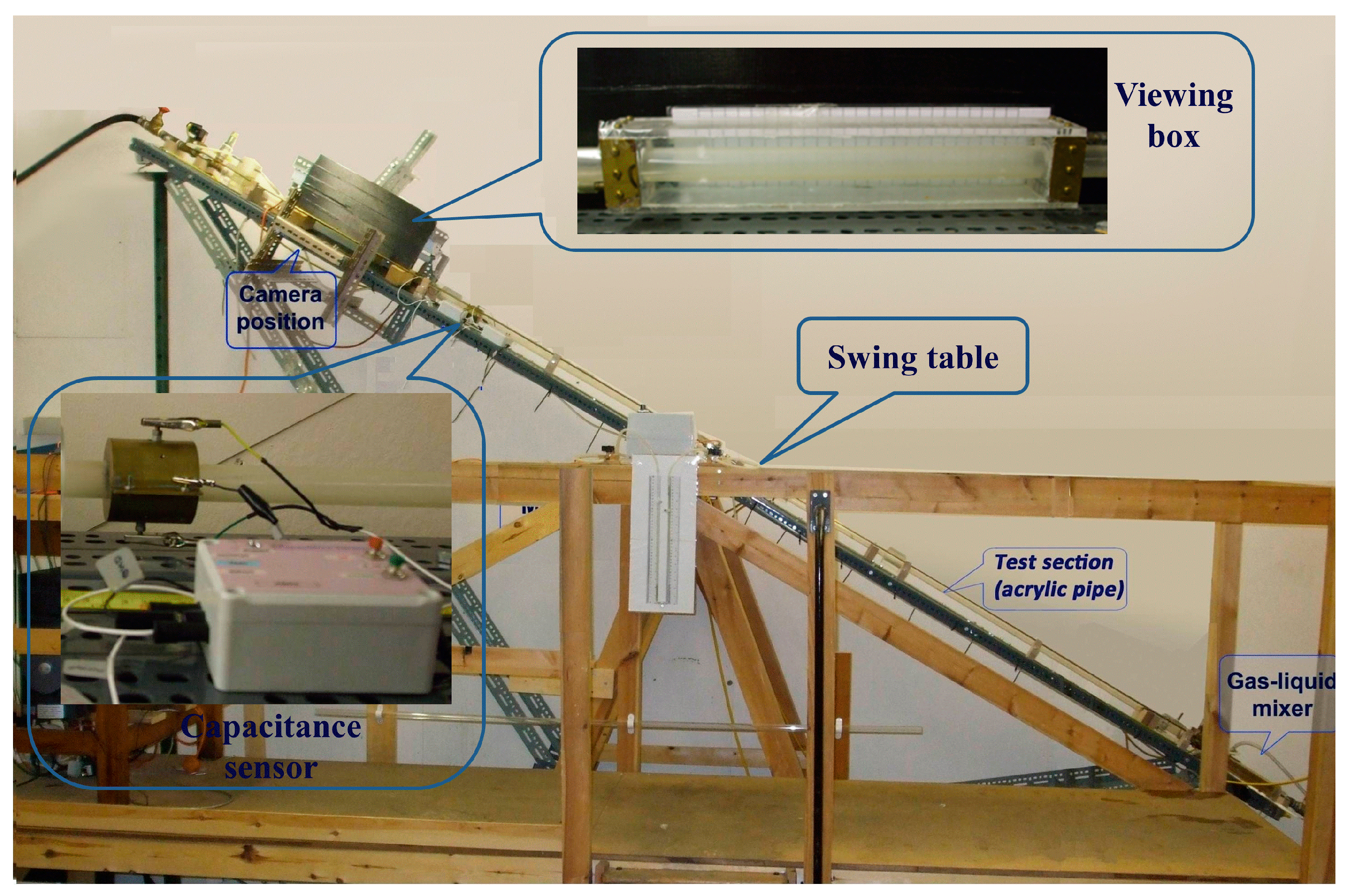
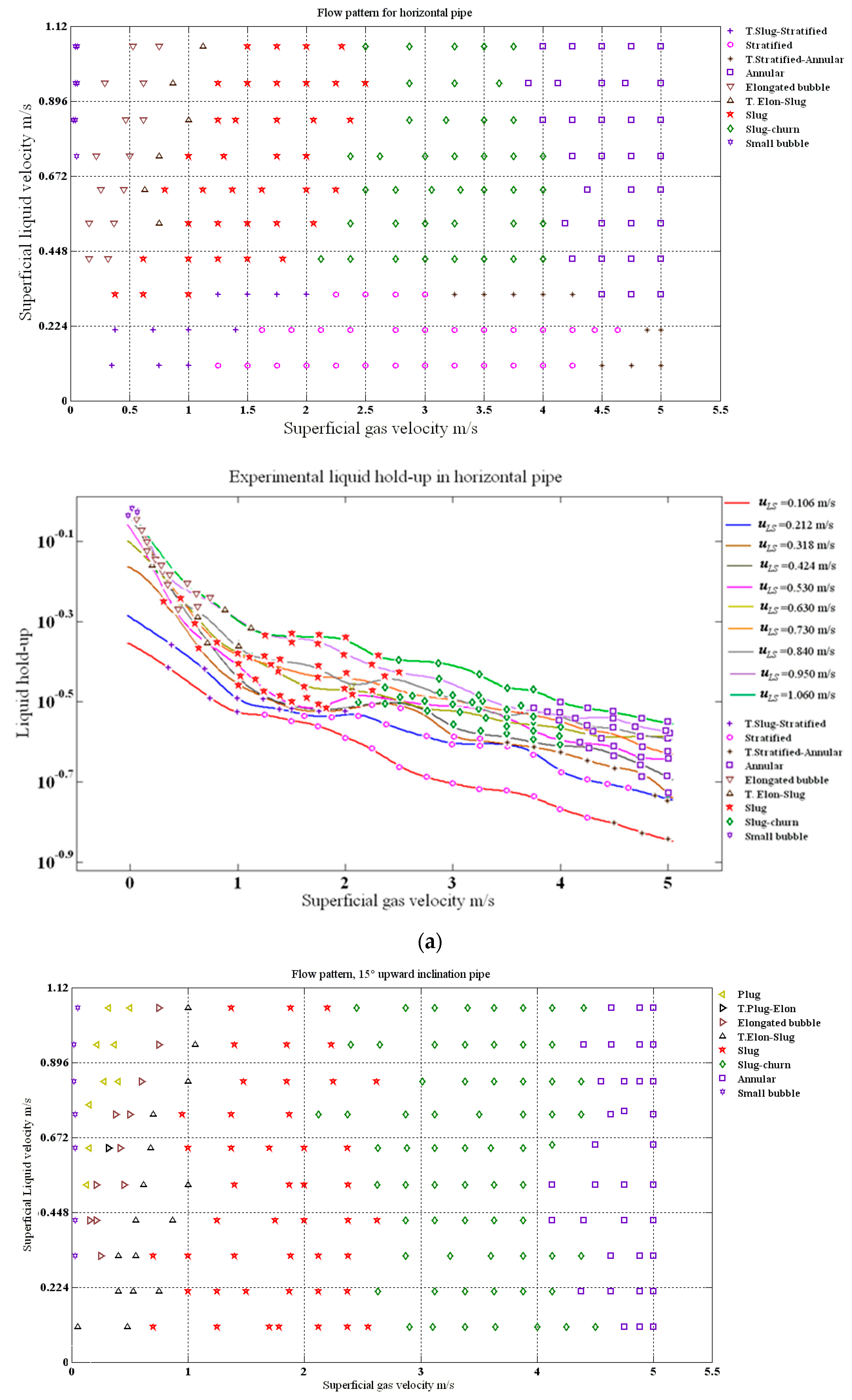
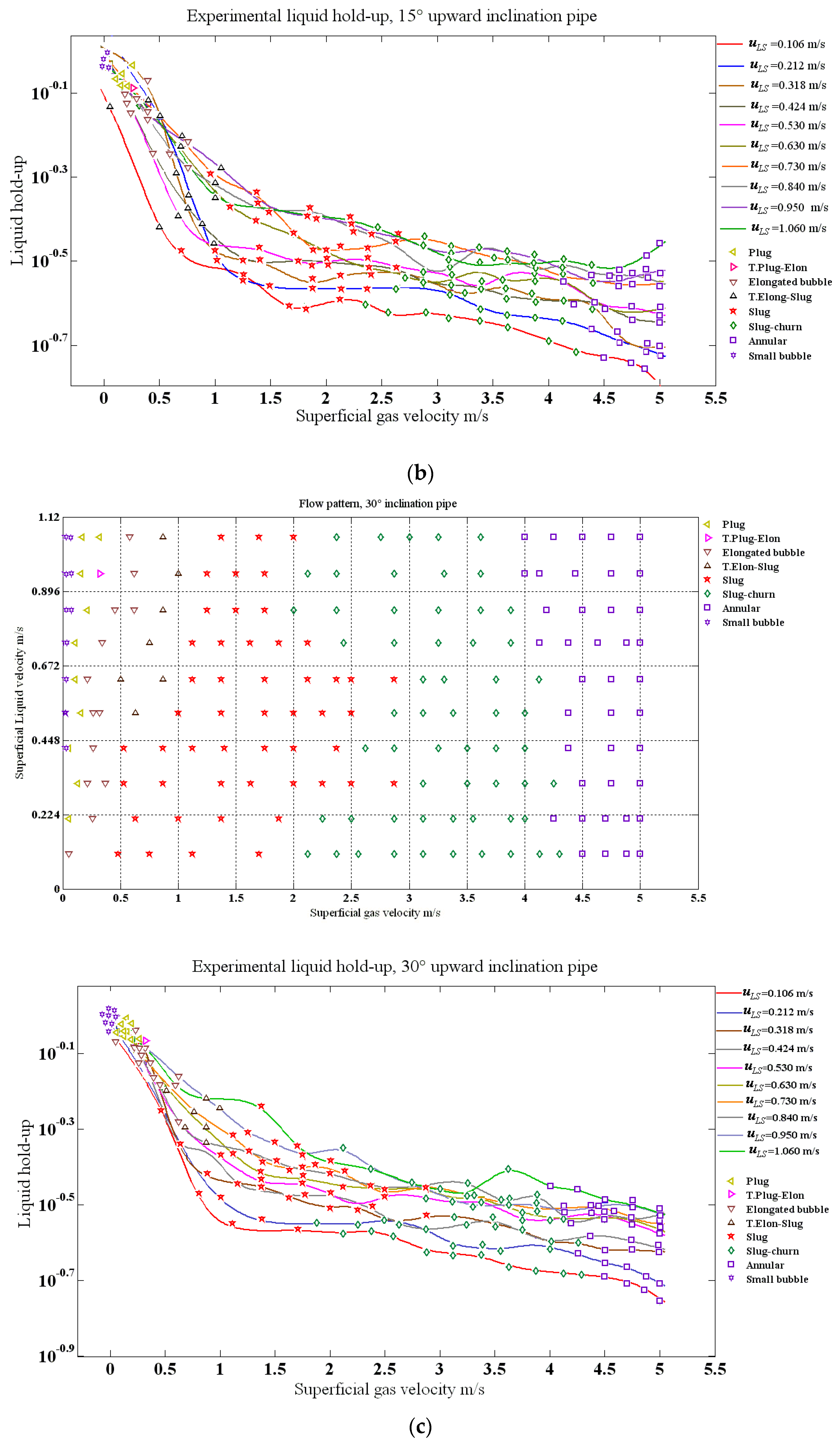
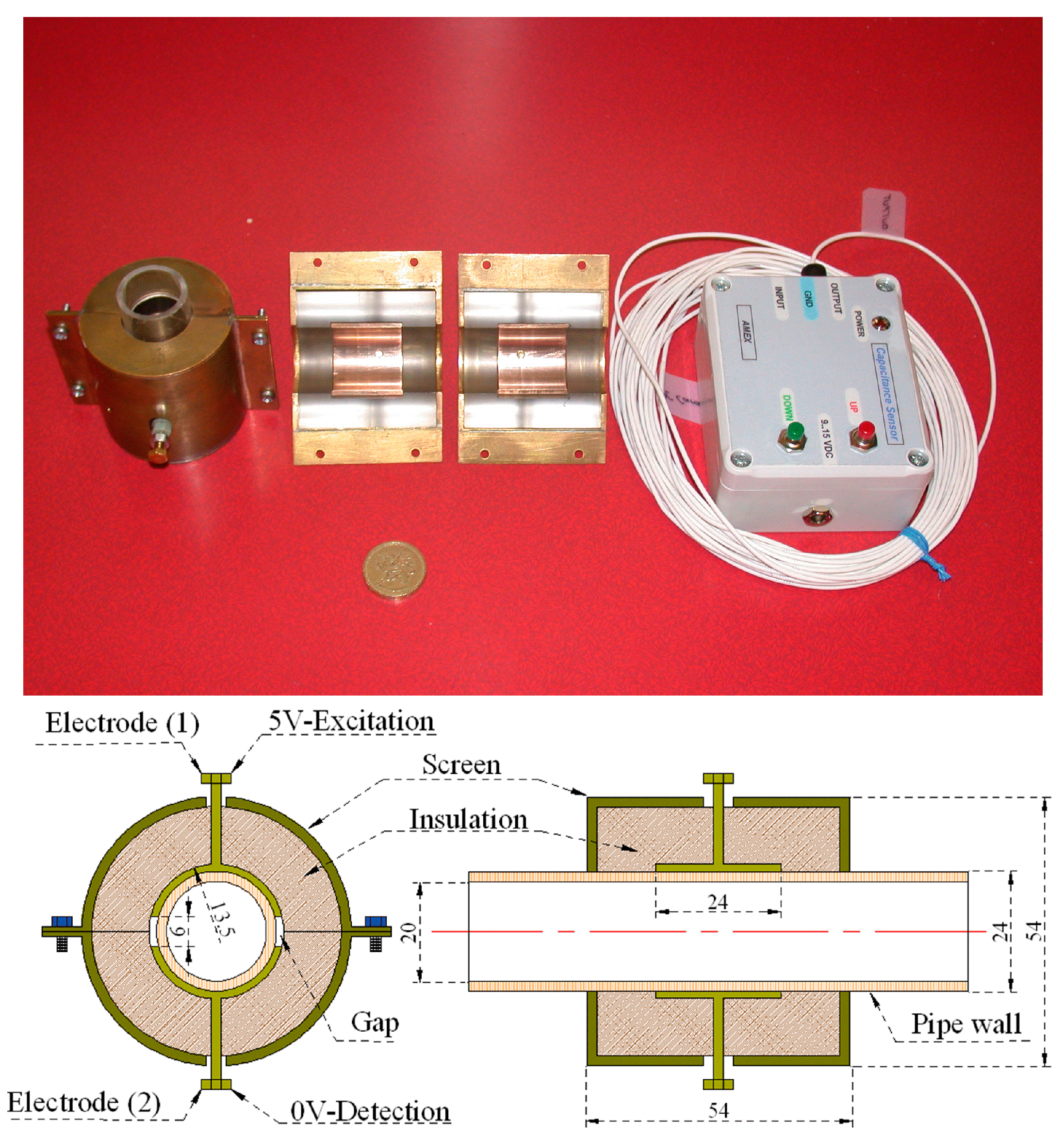
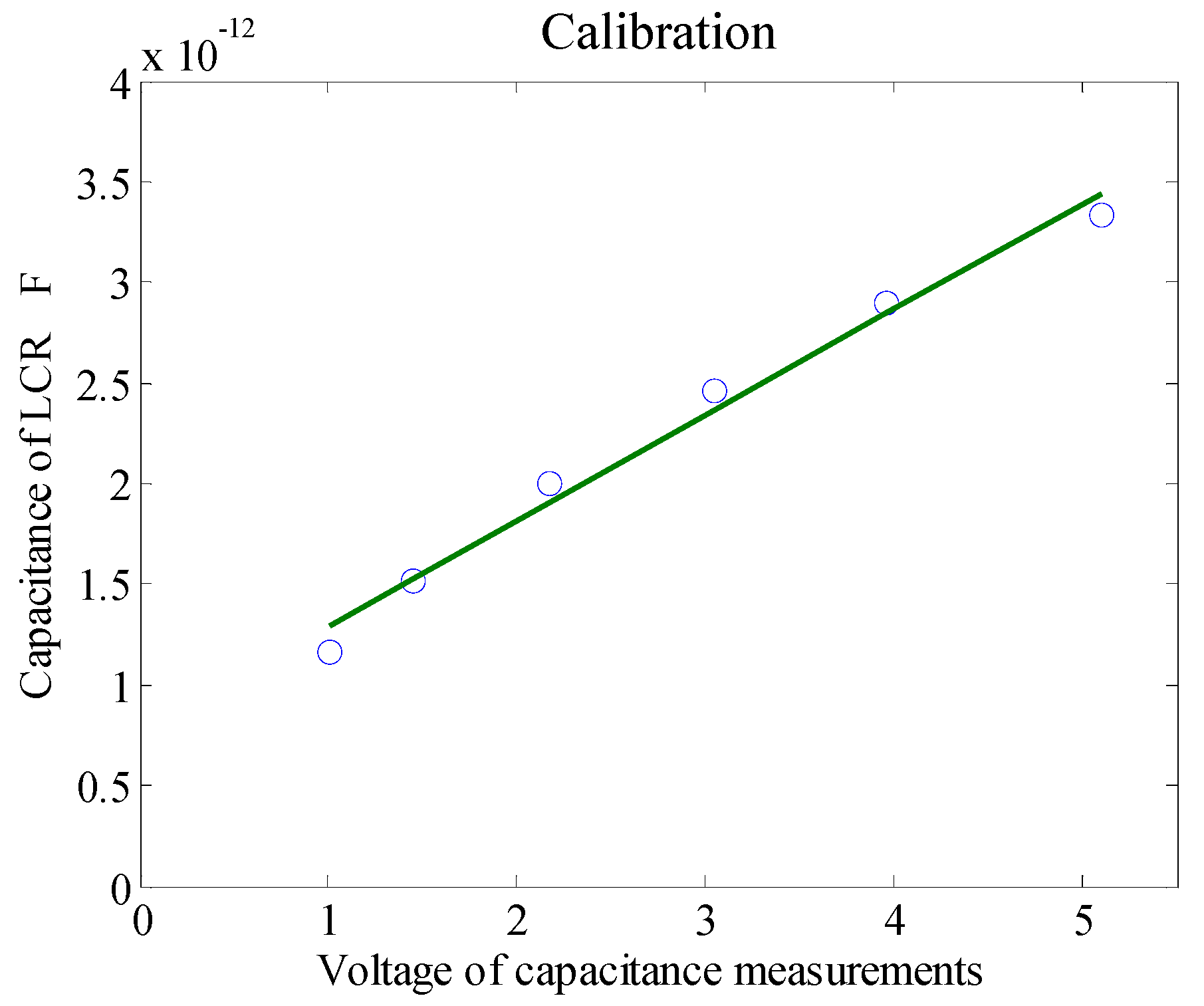
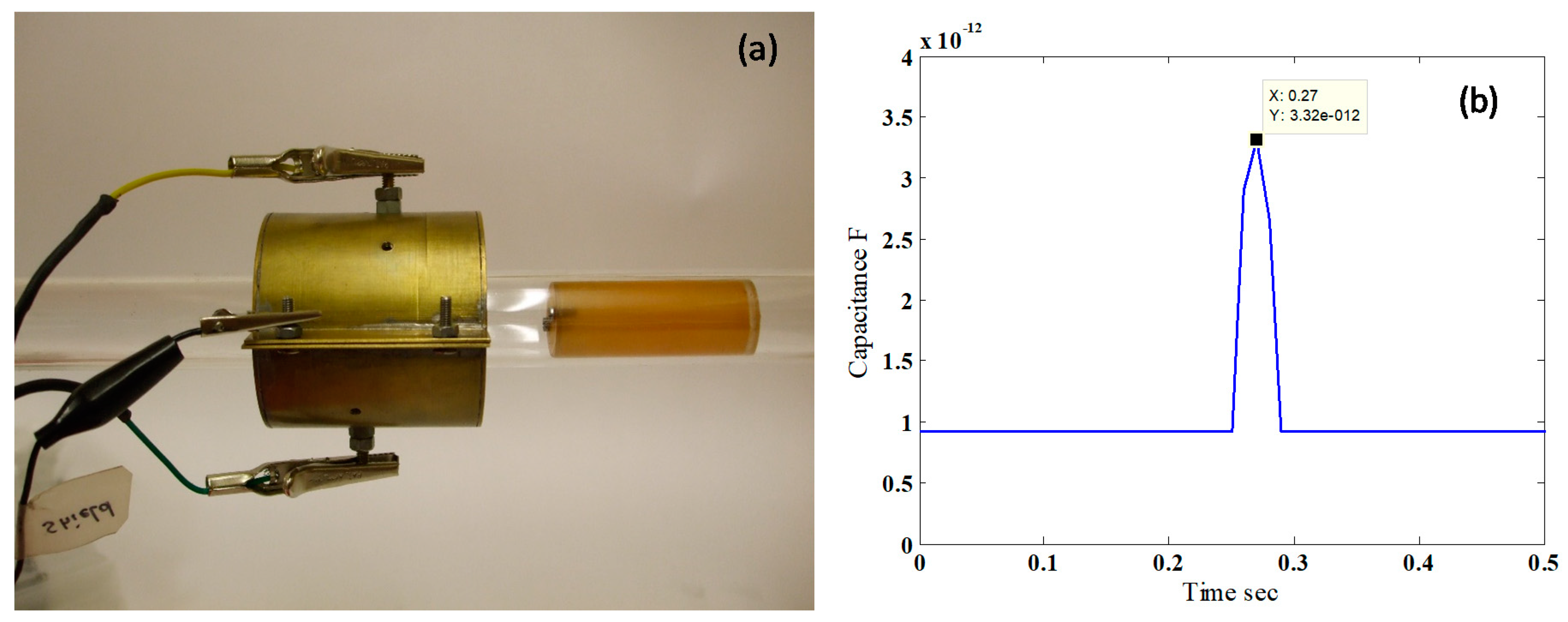
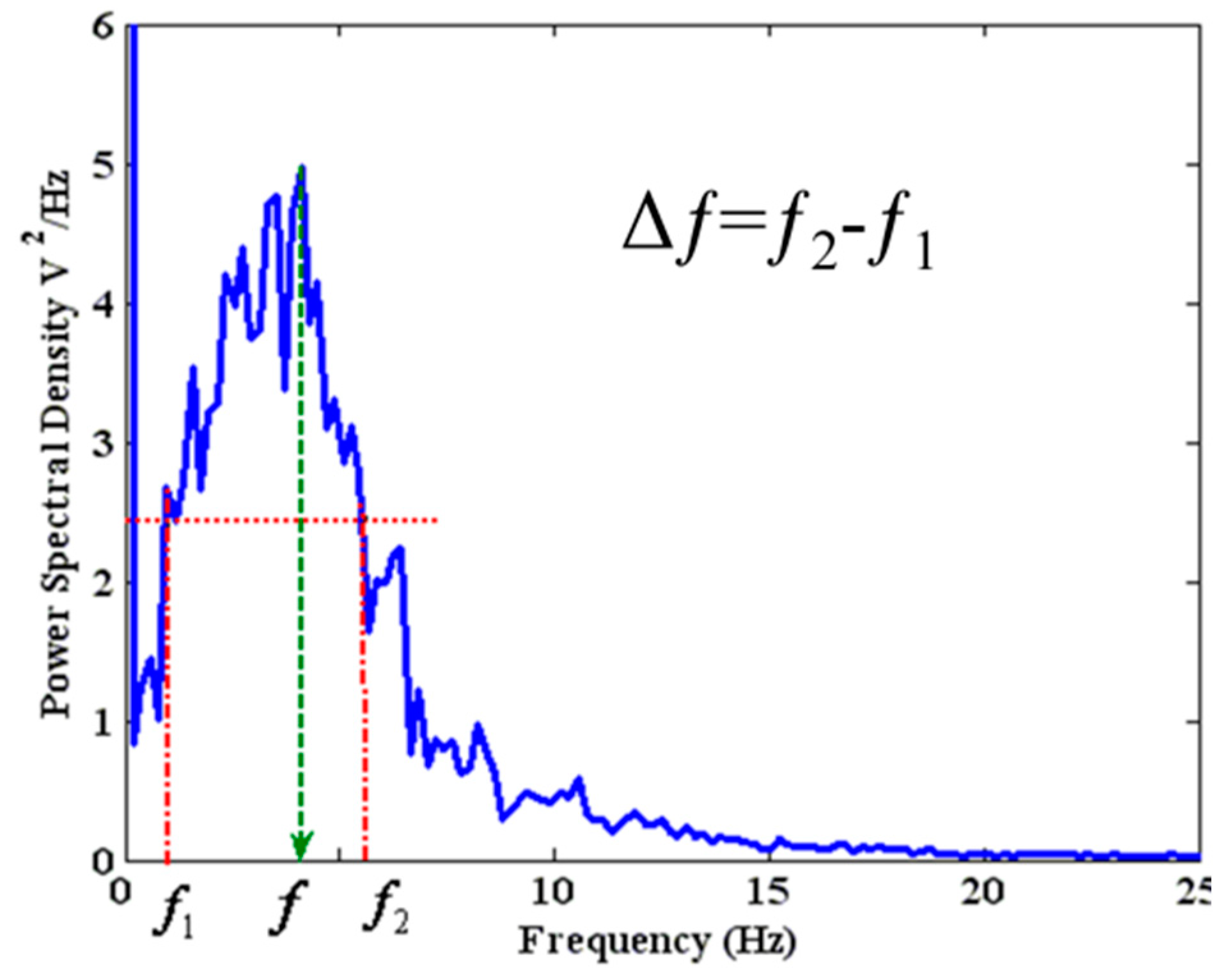



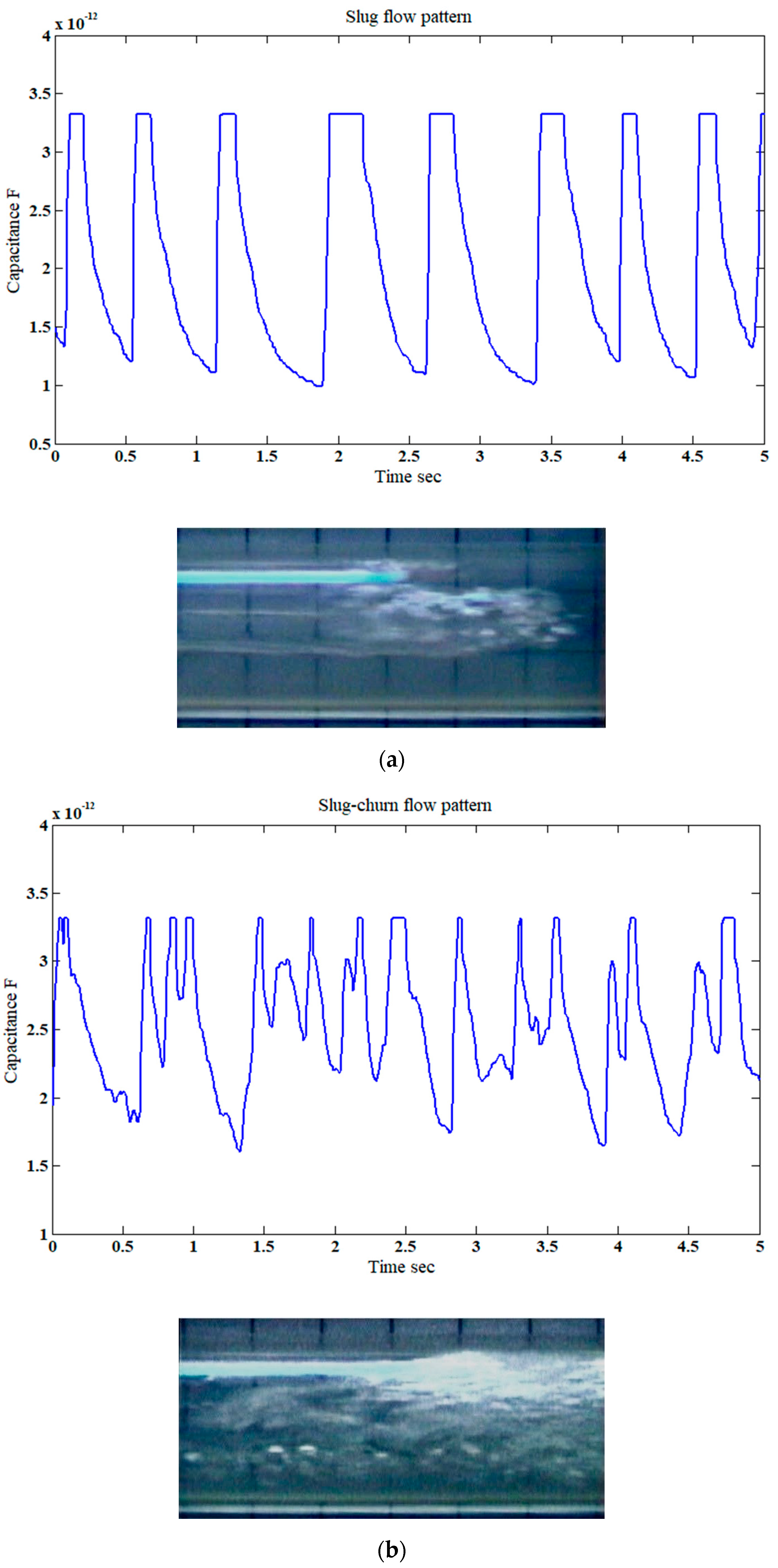


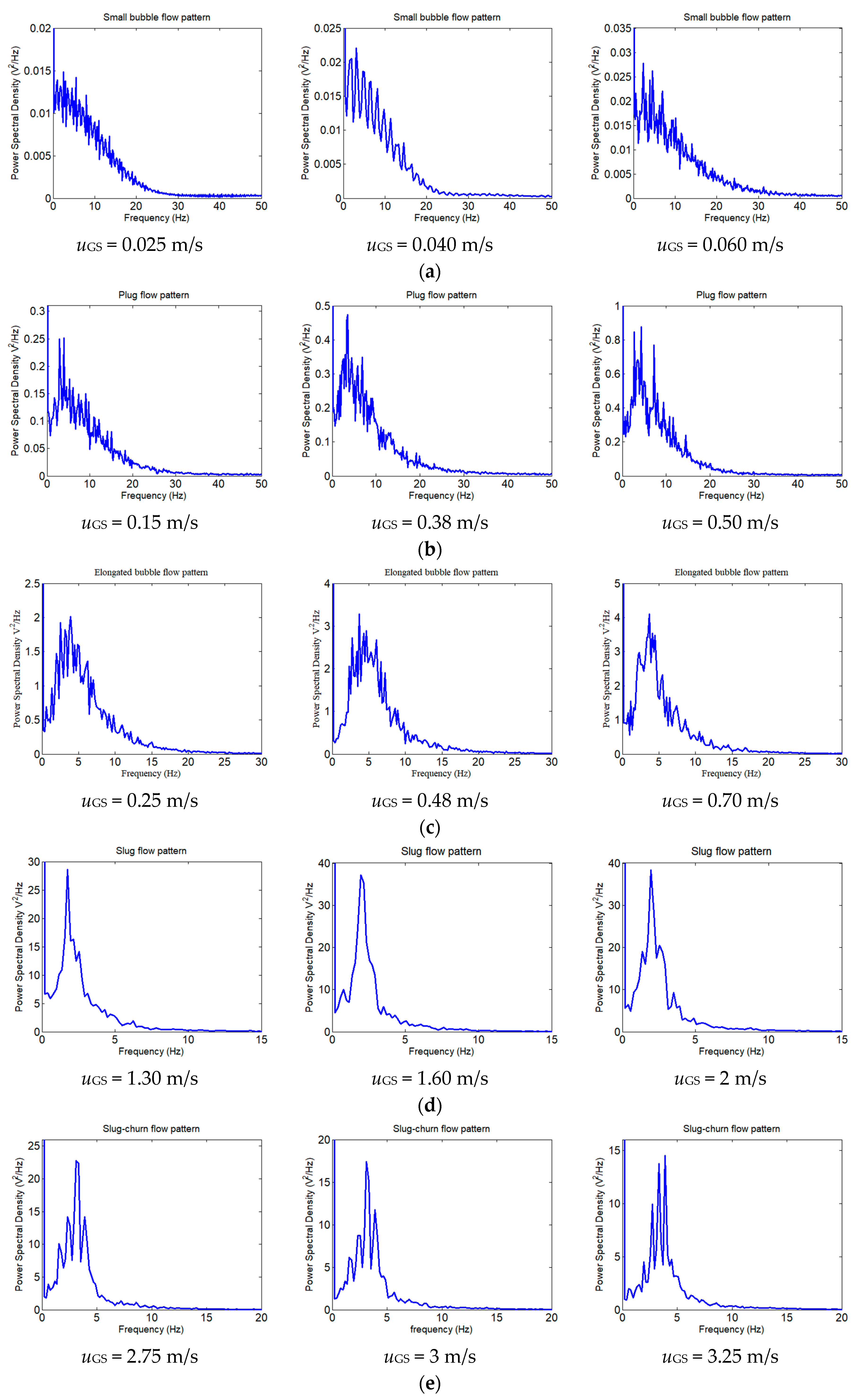
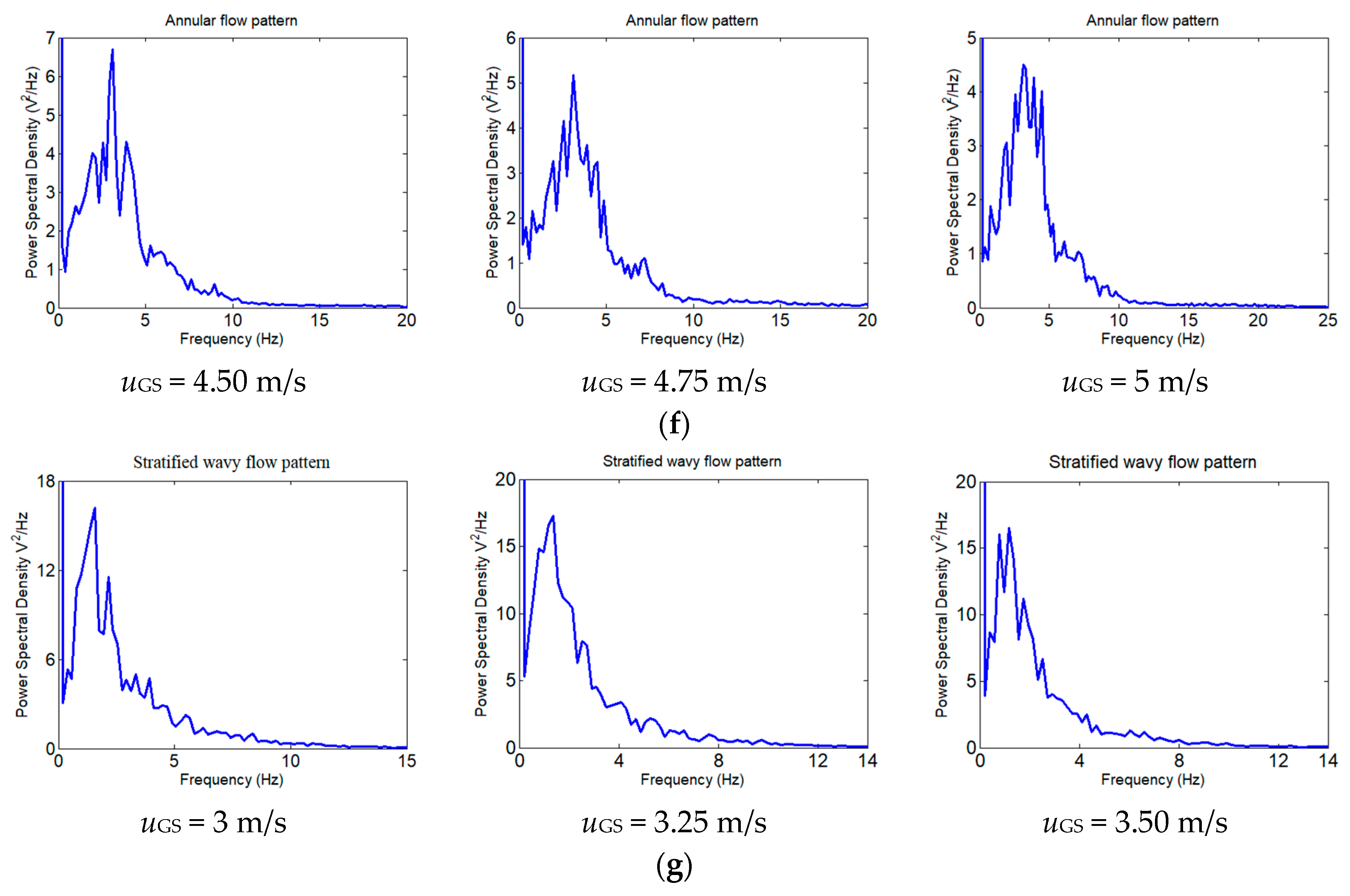
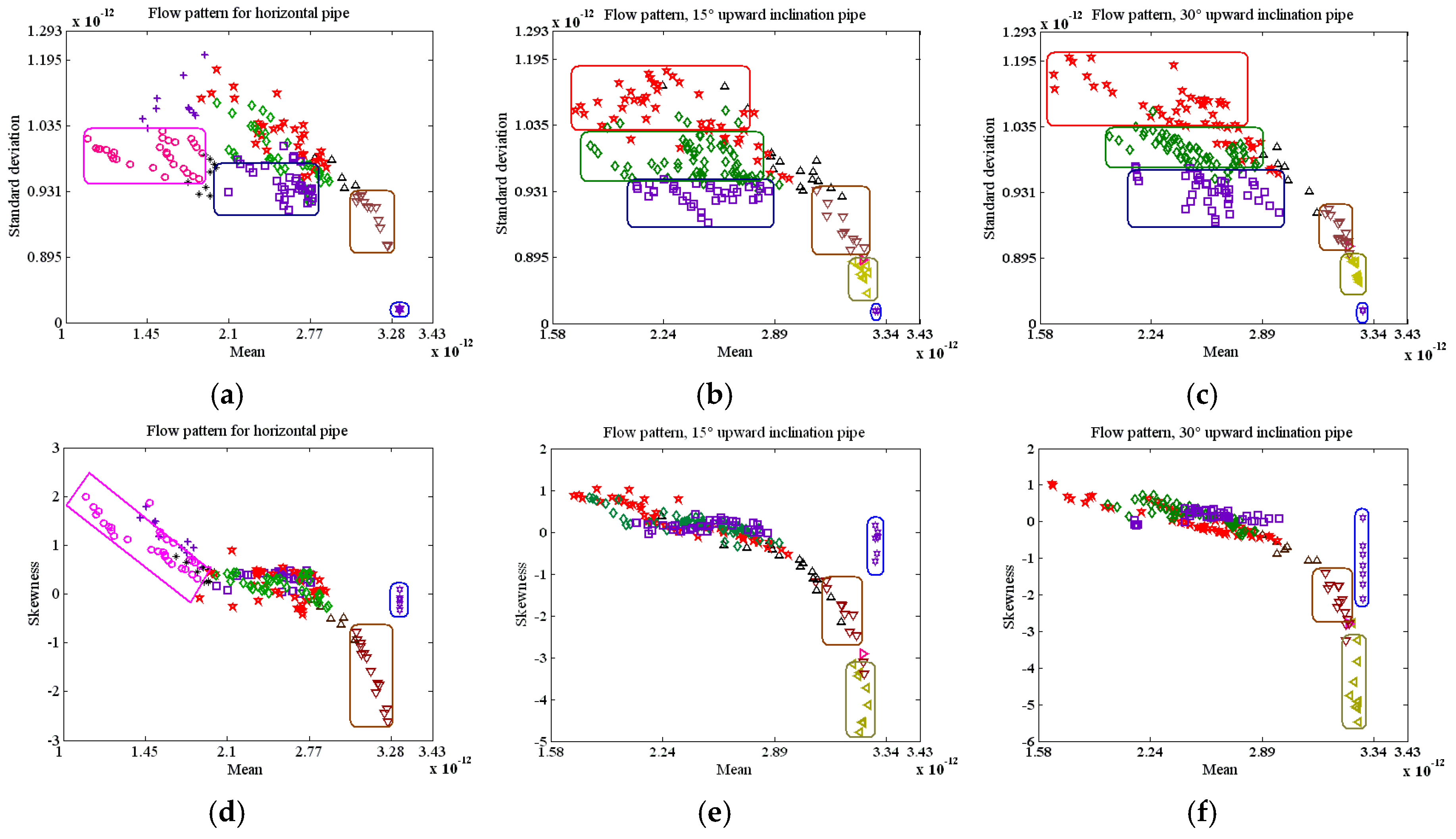





| β | vs. m | Δƒ vs. Total Power | Δƒ vs. m | Δƒ/f vs. Rem | ||||||
|---|---|---|---|---|---|---|---|---|---|---|
| 0° | Slug and slug-churn not identified | Slug, slug-churn and annular not identified | Slug, slug-churn and annular not identified | Slug and slug-churn not identified | Slug and slug-churn not identified | Slug, slug-churn and annular not identified | All identified | All identified | Slug and stratified not identified | Only slug and annular identified |
| 15° | All identified | Slug, slug-churn and annular not identified | Slug, slug-churn and annular not identified | All identified | All identified | Slug, slug-churn and annular not identified | All identified | All identified | All identified | Only slug-churn and annular identified |
| 30° | All identified | Slug, slug-churn and annular not identified | Slug, slug-churn and annular not identified | All identified | All identified | Slug, slug-churn and annular not identified | Slug and slug-churn not identified | Slug and slug-churn not identified | All identified | Only slug-churn and annular identified |
© 2020 by the authors. Licensee MDPI, Basel, Switzerland. This article is an open access article distributed under the terms and conditions of the Creative Commons Attribution (CC BY) license (http://creativecommons.org/licenses/by/4.0/).
Share and Cite
Al-Alweet, F.M.; Jaworski, A.J.; Alghamdi, Y.A.; Almutairi, Z.; Kołłątaj, J. Systematic Frequency and Statistical Analysis Approach to Identify Different Gas–Liquid Flow Patterns Using Two Electrodes Capacitance Sensor: Experimental Evaluations. Energies 2020, 13, 2932. https://doi.org/10.3390/en13112932
Al-Alweet FM, Jaworski AJ, Alghamdi YA, Almutairi Z, Kołłątaj J. Systematic Frequency and Statistical Analysis Approach to Identify Different Gas–Liquid Flow Patterns Using Two Electrodes Capacitance Sensor: Experimental Evaluations. Energies. 2020; 13(11):2932. https://doi.org/10.3390/en13112932
Chicago/Turabian StyleAl-Alweet, Fayez M., Artur J. Jaworski, Yusif A. Alghamdi, Zeyad Almutairi, and Jerzy Kołłątaj. 2020. "Systematic Frequency and Statistical Analysis Approach to Identify Different Gas–Liquid Flow Patterns Using Two Electrodes Capacitance Sensor: Experimental Evaluations" Energies 13, no. 11: 2932. https://doi.org/10.3390/en13112932
APA StyleAl-Alweet, F. M., Jaworski, A. J., Alghamdi, Y. A., Almutairi, Z., & Kołłątaj, J. (2020). Systematic Frequency and Statistical Analysis Approach to Identify Different Gas–Liquid Flow Patterns Using Two Electrodes Capacitance Sensor: Experimental Evaluations. Energies, 13(11), 2932. https://doi.org/10.3390/en13112932







